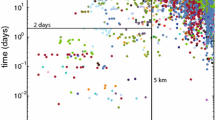Abstract
The M 5.1 event (May 23, 1993) which occurred in one of the most active swarm areas of Japan was preceded by foreshock activity. We obtained precise hypocenters of the foreshock-main-shock-aftershock sequences with a temporary seismic network installed just above the source region twenty days before the mainshock. The foreshocks are very unique in their accelerating activity; the acceleration in the number of foreshocks enabled us to estimate the time of the mainshock with time-to-failure analysis proposed by VOIGHT (1988). Although substantial snow remained in the swarm area, we quickly installed the network because the time-to-failure analysis disclosed that the mainshock was impending. The temporary network provided detailed information on both the temporal and spatial distribution of the foreshock-mainshock-aftershock sequences. Foreshocks started fifty days before the mainshock and were distributed linearly at the base of the seismogenic layer with a length of 5 km and horizontal and vertical widths of about 1 km. The temporal change of the number of foreshocks is approximated by a power law, and the time of the mainshock can be estimated by extrapolating plots of the inverse of the daily number of events. An area of seismic quiescence appeared 40 hours before the mainshock and propagated with a rate of 20 m/hour. The mainshock occurred 2 km westward from the primary foreshock area. It was located at the base of the aftershock region. This process can be interpreted as source nucleation; preslip on the fault prior to the mainshock.
Access this chapter
Tax calculation will be finalised at checkout
Purchases are for personal use only
Preview
Unable to display preview. Download preview PDF.
Similar content being viewed by others
References
Bufe, C. G., and Varnes, D. J. (1993), Predictive Modeling of the Seismic Cycle of the Greater San Francisco Bay Region, J. Geophys. Res. 98, 9871–9883.
Bufe, C. G., Nishenko, S. P., and Varnes, D. J. (1994), Seismic Trends and Potential for Large Earthquakes in the Alaska-Aleutian Region, Pure appl. geophys. 142, 83–99.
Dieterich, J. H., A model for the nucleation of earthquake slip. In Earthquake Source Mechanics, M. Ewing Ser. 6 (eds. Das, S., Boatwright, J., and Scholz, C. H.) (American Geophysical union, Washington D.C. 1986) pp. 297–332.
Dieterich, J. H. (1992), Earthquake Nucleation on Faults with Rate-and State-dependent Strength, Tectonophysics 211, 115–134.
Dodge, D. A., Beroza, G. C., and Ellsworth, W. L. (1996), Detailed Observation of California Foreshock Sequences: Implications for the Earthquake Initiation Process, J. Geophys. Res. 101, 22,371–22,392.
Ellsworth, W. L., and Beroza, G. C. (1995), Seismic Evidence for Earthquake Nucleation Phase, Science 268, 851–855.
Hirahara, K., et al. (1992), Three-dimensional P- and S-wave Velosity Structure in the Focal Region of the 1984 Western Nagano Prefecture Earthquake, J. Phys. Earth 40, 343–360.
Hirata, N., and Matsu’ura, M. (1987), Maximum-likelihood Estimation of Hypocenter with Origin Time Eliminated Using Nonlinear Inversion Technique, Phys. Earth Planet. Int. 47, 50–61.
Ishibashj, K., Specification of a soon-to-occur seismic faulting in the Tokai district, central Japan, based upon seismotectoics. In Earthquake Prediction: An International Review, M. Ewing Ser. 4 (eds. Simpson, D., and Richards, P.) (American Geophysical Union, Washington D.C. 1981) pp. 297–332.
Jones, L. M., and Molnar, P. (1979), Some Characteristics of Foreshocks and their Possible Relation-ship to Earthquake Prediction and Premonitory Slip Faults, J. Geophys. Res. 84, 3596–3608.
Mogi, K., Earthquake Prediction (Academic Press 1985) 355 pp.
Nagoya University (1993a), Prediction of M 5.1 Earthquake at Western Nagano Prefecture, Rep. Coordinating Committee for Earthquake Prediction 50, 141–145 (in Japanese).
Nagoya University (1993b), The 1993 Seismic Activity in the Southeastern Foot of Mt. Ontake, Rep. Coordinating Committee for Earthquake Prediction 50, 132–140 (In Japanese).
Ohnaka, M. (1992), Earthquake Source Nucleation: A Physical Model for Short-term Precursors, Tectonophysics 211, 149–178.
Ooida, T., Yamazaki, F., Fuju, I., and Aoki, H. (1989), Aftershock Activity of the 1984 Western Nagano Prefecture Earthquake, Central Japan, and its Relation to Earthquake Swarms, J. Phys. Earth. 37, 401–416.
Papazachos, B. C. (1973), Foreshocks and Earthquake Prediction, Tectonophysics 28, 213–226.
Tokarev, P. I. (1973), Forecasting Volcanic Eruptions from Seismic Data, Bull. Volcanology 35, 243–250.
Voight, B. (1988), A Method for Prediction of Volcanic Eruptions, Nature 332, 125–130.
Yamashita, T., and Ohnaka, M. (1992), Precursory Surface Deformation Expected from a Strike-slip Fault Model into which Rheological Properties of the Lithosphere are Incorporated, Tectonophysics 211, 179–199.
Author information
Authors and Affiliations
Editor information
Editors and Affiliations
Rights and permissions
Copyright information
© 1999 Birkhäuser Verlag
About this chapter
Cite this chapter
Yamaoka, K., Ooida, T., Ueda, Y. (1999). Detailed Distribution of Accelerating Foreshocks before a M 5.1 Earthquake in Japan. In: Wyss, M., Shimazaki, K., Ito, A. (eds) Seismicity Patterns, their Statistical Significance and Physical Meaning. Pageoph Topical Volumes. Birkhäuser, Basel. https://doi.org/10.1007/978-3-0348-8677-2_7
Download citation
DOI: https://doi.org/10.1007/978-3-0348-8677-2_7
Publisher Name: Birkhäuser, Basel
Print ISBN: 978-3-7643-6209-6
Online ISBN: 978-3-0348-8677-2
eBook Packages: Springer Book Archive




